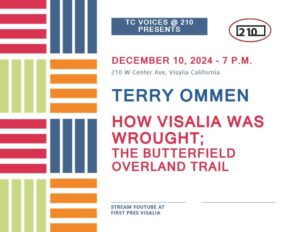
The Overland Stage Line would be one of the first successful attempts to connect the East Coast of the United States with the nation’s new holdings on the West Coast. Although the Gold Rush of 1849 and subsequent statehood for California in 1850 brought settlers, business and enterprise to the Golden State, it remained isolated in communication and commerce. Several attempts were made in the 1850s to provide shipping and mail service from the East Coast cities of New York, Boston and Washington to California, but all faltered – until an entrepreneur named John Butterfield fashioned the stage coach route that spanned the continent.
Visalia became a significant outpost on the stage route. Its success helped transform Visalia from fledgling settlement to one of the most important cities in central California.
The telling of this remarkable tale has fallen to Visalia historian Terry Ommen, who once again will be the featured speaker for Tulare County Voices at 210, when it presents “The Butterfield Overland Stage: How Visalia Connected with the World.”
The forum will be at 7 p.m. on Tuesday, Dec. 10 at 210 W. Center Ave. in downtown Visalia. The event is free. Doors open at 6:30 p.m. It will also be streamed on the First Presbyterian Church website and YouTube pages.
Tulare County Voices at 210 is a monthly forum co-sponsored by the Visalia Times-Delta and First Presbyterian Church that explores topics of local interest.
Ommen has presented history forums in December for several years at 210. His talks have covered subjects such as Visalia’s Chinatown, the transformation of historical buildings, famous outlaws and lawmen, Fort Visalia, and Visalia in the Civil War, among others.
This month’s topic covers one of the most transformative events in Tulare County history. The stage brought people and business to the area, and with the advent of the telegraph and later the railroad, literally connected Visalia to the world.
It started in the mid-1850s when the U.S. government, eager to connect with its new states and territories acquired as a result of its war with Mexico, offered business people incentives to link east and west. There was one stipulation: the 2,700-mile route had to be traversed in no more than 25 days. It fell to an upstate New York businessman, John Butterfield, to figure out how to do it. The federal government awarded him a contract for $600,000 a year to deliver mail twice a week between San Francisco and St. Louis. Butterfield had one year to get the operation up and running.
Butterfield was no rookie at running stage lines. For 30 years, from his headquarters in upstate New York, he had built and operated several such lines. Eventually they would merge to become Wells Fargo.
Butterfield and his partners mapped out and traveled a route that ran through the Southwest – San Francisco to Los Angeles, then west through Arizona, New Mexico, Texas, Oklahoma, Arkansas and Missouri. It was called the “Oxbow” route because it formed a wide bow as it dipped south from San Francisco toward Mexico before climbing back northward to St. Louis.
Butterfield established 170 stations along the route between 10 and 20 miles apart. Stages would change horses, get fresh water and replace drivers or equipment as needed.
Visalia was designated as a “timetable” stop, where the stage would be checked to see whether it was on schedule, and team and passengers could get extra rest and food. The stages carried mail and correspondence, but no payrolls, and the drivers were unarmed. The first stage made the trip from San Francisco to St. Louis in 24 days. By 1859, the time was down to 21.5 days.
Two stages traveling through Visalia twice a week – two each way – became a boon for local saloons, livery stations, eateries, inns and other vendors.
The Overland Stage ran faithfully until March 1861, when the emerging Civil War brought it to an end. Confederate forces confiscated most of the 100 or so stages used in the system. The Pony Express briefly replaced the transcontinental mail service.
Remnants of the Overland Stage Route continued in service until the late 1880s.
The telegraph arrived in Visalia in 1861, and newspapers began publication in California to inform people about the Civil War. By the end of the decade, the railroad had arrived.
All those developments connected Visalia with the rest of California and the world.
But the first of them was the Butterfield Overland Stage Line.
Learn more about its remarkable influence on Visalia at Tulare County Voices at 210 with Terry Ommen on Dec. 10, and join the community conversation.
